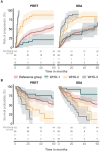The concept, intention, and evaluation of the term treatment-refractory meningioma
- PMID: 40760312
- PMCID: PMC12420741
- DOI: 10.1007/s11060-025-05154-2
The concept, intention, and evaluation of the term treatment-refractory meningioma
Abstract
Background: Treatment-refractory meningioma is a widely used term but lacks standardized criteria, impairing research comparability and treatment evaluation. The aim of this study was to assess the heterogeneity of patient populations labeled as treatment-refractory and to explore recommendations for better consistency.
Methods: We systematically reviewed 69 studies published before 2024 and analyzed individual participant data from 15 cohorts (n = 211) that included treatment-refractory patients who underwent experimental therapy with somatostatin receptor (SSTR)-targeted therapies. A reference cohort (n = 102) with newly diagnosed WHO-3 meningiomas was used descriptively for comparison. Progression and death were the primary endpoints. Hazard rate ratios were estimated via Poisson regression, and inter-study heterogeneity was quantified using I² statistics.
Results: Definitions of treatment-refractory varied substantially across previous studies. WHO-1 patients showed high statistical inter-study variability, particularly for the long-acting SSTR-analogues group when assessing progression (I² = 81.7%) and death (I² =74.8%). Patients with treatment-refractory WHO-2 and WHO-3 meningioma exhibited more consistency across endpoints and SSTR-targeted therapies (I² percentages ≤ 16.0%). Risk of progression and death differed significantly by WHO grade, regardless of SSTR-targeted therapy.
Conclusions: Our findings demonstrate an inconsistent use of the term treatment-refractory and substantial variability of effect estimates dependeing on the individual cohorts. Pooling patients across WHO grades is unfeasible for assessing treatment effects. Based on the present study and prior evidence, we outline recommendations to improve consistency in future trial design and enable more meaningful comparisons across studies. The recommendations are grouped into four categories: radiographic evaluation, endpoints, clinical core elements, and molecular classification.
Keywords: Individual participant data; Progressive meningioma; Recommendations; Retrospective cohort; Treatment-refractory.
© 2025. The Author(s).
Conflict of interest statement
Declarations. Ethics approval: As the manuscript relies entirely on published and fully anonymized material, ethical approval was not required. Competing interests: The authors declare no competing interests.
Figures




References
Publication types
MeSH terms
LinkOut - more resources
Full Text Sources

